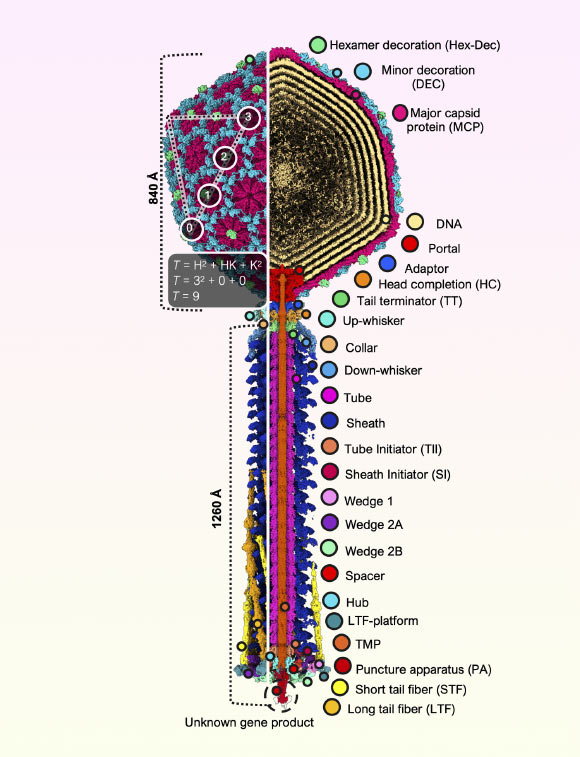Using cryo-electron microscopy, researchers have investigated the structure of Bas63, a bacteriophage of the subfamily Ounavirinae and the Felixounavirus genus which targets Escherichia coli, to explore its evolutionary relationships and functional adaptations.

Composite representation of the complete Bas63 virion. Image credit: Hodgkinson-Bean et al., doi: 10.1126/sciadv.adx0790.
Bacteriophages of the class Caudoviricetes represent the most abundant group of viruses on Earth.
Caudoviricetes includes 7 orders, 74 families, and 121 subfamilies.
“Bacteriophages are extremely exciting in the scientific world as researchers search for antibiotic alternatives to combat the increasing risk of antimicrobial resistance,” said Dr. James Hodgkinson-Bean, a researcher at the University of Otago.
“Bacteriophage viruses are non-harmful to all multi-cellular life and able to very selectively target and kill a target bacterium.”
“Due to this, they are increasingly being researched and applied in ‘phage therapy’ to treat highly drug-resistant bacteria.”
“Bacteriophages are exquisitely intricate viruses which infect bacteria through large mechanical structures described as ‘tails’.”
For the study, Dr. Hodgkinson-Bean and his colleagues explored the structure of Bas63 in molecular detail to understand how their tail works during infection.
“This kind of research is important for understanding how we can select the optimal bacteriophages for therapies, and to understand the differences in infectious behavior we see in the lab,” Dr. Hodgkinson-Bean said.
“With antibiotic resistance rising and plant pathogens threatening global food security, bacteriophages offer a promising alternative,” added Dr. Mihnea Bostina, also from the University of Otago.
“Our detailed blueprint of a bacteriophage advances rational design for medical, agricultural, and industrial applications, from treating infections to combating biofilms in food processing and water systems.”
“Beyond science, the 3D data — which shows the virus’ rare whisker-collar connections, hexamer decoration proteins, and diverse tail fibers — may inspire artists, animators, and educators.”
Understanding the structure of the viruses also aids understanding of their evolution.
“While DNA generally serves as the best evolutionary marker in humans, the 3-dimensional structure of a virus is more informative of its distant evolutionary relationships with other viruses,” Dr. Hodgkinson-Bean said.
The authors found features only previously found in very distantly related viruses, revealing previously unknown evolutionary links between them.
“We know through structural studies that bacteriophages are related to Herpes viruses — this relationship is thought to extend back billions of years to before the emergence of multi-cellular life,” Dr. Hodgkinson-Bean said.
“For this reason, when we look at bacteriophage structure, we are looking at living fossils, primordial ancient beings.”
“There is something truly beautiful about that.”
The findings were published on November 12, 2025 in the journal Science Advances.
_____
James Hodgkinson-Bean et al. 2025. Cryo-EM structure of bacteriophage Bas63 reveals structural conservation and diversity in the Felixounavirus genus. Science Advances 11 (46); doi: 10.1126/sciadv.adx0790







